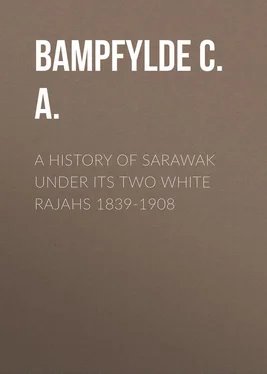C. Bampfylde - A History of Sarawak under Its Two White Rajahs 1839-1908
Здесь есть возможность читать онлайн «C. Bampfylde - A History of Sarawak under Its Two White Rajahs 1839-1908» — ознакомительный отрывок электронной книги совершенно бесплатно, а после прочтения отрывка купить полную версию. В некоторых случаях можно слушать аудио, скачать через торрент в формате fb2 и присутствует краткое содержание. ISBN: , Жанр: foreign_antique, foreign_prose, на английском языке. Описание произведения, (предисловие) а так же отзывы посетителей доступны на портале библиотеки ЛибКат.
- Название:A History of Sarawak under Its Two White Rajahs 1839-1908
- Автор:
- Жанр:
- Год:неизвестен
- ISBN:http://www.gutenberg.org/ebooks/52873
- Рейтинг книги:4 / 5. Голосов: 1
-
Избранное:Добавить в избранное
- Отзывы:
-
Ваша оценка:
- 80
- 1
- 2
- 3
- 4
- 5
A History of Sarawak under Its Two White Rajahs 1839-1908: краткое содержание, описание и аннотация
Предлагаем к чтению аннотацию, описание, краткое содержание или предисловие (зависит от того, что написал сам автор книги «A History of Sarawak under Its Two White Rajahs 1839-1908»). Если вы не нашли необходимую информацию о книге — напишите в комментариях, мы постараемся отыскать её.
A History of Sarawak under Its Two White Rajahs 1839-1908 — читать онлайн ознакомительный отрывок
Ниже представлен текст книги, разбитый по страницам. Система сохранения места последней прочитанной страницы, позволяет с удобством читать онлайн бесплатно книгу «A History of Sarawak under Its Two White Rajahs 1839-1908», без необходимости каждый раз заново искать на чём Вы остановились. Поставьте закладку, и сможете в любой момент перейти на страницу, на которой закончили чтение.
Интервал:
Закладка:
The next Indonesian tribes to follow were the Kayans and then the Kenyahs, two that are closely allied, and both, according to tradition, came from the south, probably from the Celebes. They took possession of the Belungan (or Batang Kayan) river-basin, and overflowed into those of Baram and Balui (the right hand branch of the Rejang). These powerful tribes found these river-basins unoccupied except by scattered families of the tribes above mentioned, whom they drove into the jungle. In the Baram they remained undisturbed, as also in the Rejang till recent years. Down the latter river they spread as far as Kapit; at that time both the Sea-Dayaks and Malays were there, and over them the Kayans domineered, driving the former from their settlements at Ngmah, 21 21 The Indra Lila (brother of the Lila Pelawan, who was the present Rajah's Malay chief at Lingga over fifty years ago), was their chief. Trouble arose owing to Akam Nipa, the celebrated Kayan chief, who will be noticed hereafter, having fallen in love with a Malay girl of rank. His suit being rejected, he threatened to forcibly abduct the lady, a threat which he could have carried out with ease, so the Malays fled with her to Lingga. This occurred some eighty years ago.
and harassing the latter in the Kanowit, and even in the Sekrang. Eventually, however, the Kayans were forced to fall back before the ever increasing Dayaks, and to retire to the head-waters of the Balui, and now, with the exception of one small settlement, all reside above the Belaga.
When we consider the large area occupied by the tribes of Kayans and Kenyahs, who may be classed together, it will be seen how important they are. Besides inhabiting the upper waters of the Baram and Rejang, they are found in very large numbers on the Batang Kayan. The Mahkam (Koti or Coti) is also thickly inhabited by Kayans, and many live on the Barito (Banjermasin), and on the Kapuas. The Kayans and Kenyahs are tattooed, as are most of the savage people of Indonesian origin in the interior. When the children are young the lobes of the ears are pierced, and by the insertion of heavy lead or copper rings the lobes become gradually so distended as to hang down to the shoulders, and, with elderly women, often lower. That this is a very old custom, and not peculiar to these people, is shown by the sculptures in the ancient Boro Budor temple in Java, where men and women are figured with such elongated ear lobes, having ear pendants and plugs exactly similar to those in use by the Kayans and Kenyahs. Most Indonesian tribes of the interior retain this fashion. 22 22 One of Magellan's chroniclers records that in 1521 men were found in Gilo (Gilolo or Jilolo, to the east of, and near to the Celebes), "with ears so long and pendulous that they reached to their shoulders." — Magellan, Hakluyt Society. Marsden, History of Sumatra , says that the people of Neas island off the west coast of Sumatra elongate their ears in the same manner; so do the Sagais of Belungan. The sculptures above mentioned, and the fact that this curious custom still exists in southern India, point to it being one of Hindu origin.
These Kayans and Kenyahs are on a slightly higher grade of civilisation than the Sea-Dayaks, building finer houses, having more rule and order among themselves, and being expert in the manufacture of excellent weapons, extracting their iron for that purpose from the native ore. In character they are vindictive and cruel, but brave, and not without some good qualities. Formerly they practised hideous cruelties on their captives and slaves, and impalement was a common form of punishment. The women were even more barbarous than the men, being the most ingenious and inhuman in devising tortures. The Kayans under Sarawak rule have been checked in these matters, and human sacrifices have become a thing of the past. But that these propensities are only dormant is instanced by a case that occurred but a few years ago, far up the Balui. Four young Dayaks, survivors of a party of gutta-percha collectors, who had been cut off and killed by the Punans, after wandering for many days in the jungle, arrived destitute and starving at a Kayan house, and asked for food and shelter. Instead, the Kayans bound the young men, and, after breaking their legs and arms, handed them over to the women, who slowly despatched them by hacking them to pieces with little knives. And in the Baram, in 1882, a Kayan chief caused two captives to be bound and thrown down from the lofty verandah of his house to the ground, where they were decapitated – quite in Ashantee manner. 23 23 Human sacrifices are still in vogue amongst the Kayans and Kenyahs in the Batang Kayan and Mahkam rivers.
Among the Kayans and Kenyahs a broad distinction exists between the classes. There are but the chiefs and their families, and only serfs and slaves under them. The chiefs are not chosen by the people, as is the case among the Dayaks. They assume their position by right of birth, or by might. The position of the serf is little better than that of the slave, and all they may gain by their industry is seized by the chiefs. It is the difference that existed in Germany between the Freie and the Unfreie; in England in Saxon times between the thegn and the villein. Although the Kayans take heads in warfare, they do not value them as do the Dayaks, and will part with them to the latter; and they are not head-hunters in the strict sense of the term. The Kayans are a decreasing race, not so the Kenyahs. Both are capable of improvement, especially the latter; and they are improving, notably in the Baram, where they are directly under the control of the Government, since that river district was ceded to Sarawak in 1883.
The Tanjongs, Kanowits, Kajamans, and Sekapans, 24 24 The Kajamans, Sekapans, Sians, and Lanans are said to have been the first to cross over from the Bantang Kayan (Belungan) into the Balui (Rejang). They were probably then one tribe.
are cognate tribes, probably of the same stock as the Kayans and Kenyahs. Formerly they were large tribes, but are now each reduced to a solitary village. They are to be found only on the Rejang. The dialects of the two first are intermediary between those of the Melanaus and the Kayans, and they live in an intermediary position. The other two tribes live close to Belaga fort in the Kayan country; their dialects vary.
The Malohs of Kapuas in Dutch Borneo formerly had a large village at Kanowit, but nearly all have returned to their own country, and the tribe is now represented by a sprinkling only among the Sea-Dayaks. They are wonderfully skilled workers in brass and copper, and manufacture the peculiar brass corsets worn by the Sea-Dayak women, and their armlets, anklets, leg and ear-rings, and other personal ornaments; and they have been known to turn their talents to making counterfeit coin. They bear a great reputation for bravery, and are dangerous men to cross.
The Lanans live amongst the Kayans, to whom they are allied, in the Balui, and have seven or eight villages.
The Sebops and Madangs are Kenyah sub-tribes.
The Melanau, a large and most important tribe inhabiting the coast between Kedurong point and the mouths of the Rejang, is also of Indonesian stock, though, like the Malays, but in a lesser degree, they are of mixed breed. In speech these people are allied to the Kayans, and are regarded by some as a branch tribe. Certain of their customs are similar, and if they differ from the Kayans in many respects, this is due partly to environment, but mainly to the majority of them having embraced Muhammadanism, and to their having intermarried with the Malays, with whom they are now to a certain extent assimilated in customs. They cultivate sago on a large scale, and since the exit of their old Bruni rulers – or rather oppressors – are able to enjoy the fruits of their labour, and have increased their plantations considerably. At Bruit, Matu, Oya, Muka, 25 25 Muka is the Malay for face. The word has been carried into the English language as mug, contemptuously "an ugly mug," from the Sanskrit word muhka , the face.
and Bintulu, there are jungles of sago palms, and these places supply by far the largest proportion of the world's consumption of sago. The people being industrious and thrifty are well off. The above-named places are now large towns, and Muka is as large as Bruni. The Melanaus are skilled in working iron, are good carpenters, and excellent boat builders. Though they are by nature, like the cognate Kayans, vindictive and quarrelsome, serious crime is not common among them, and they are a law-abiding people. Formerly among the Kayans and Melanaus when one of their houses was about to be built, a hole was dug in the ground, a slave woman together with some beads placed in it, and the first iron-wood supporting post was levered up, and then driven through her into the ground. This was an oblation to the Earth Spirit.
Интервал:
Закладка:
Похожие книги на «A History of Sarawak under Its Two White Rajahs 1839-1908»
Представляем Вашему вниманию похожие книги на «A History of Sarawak under Its Two White Rajahs 1839-1908» списком для выбора. Мы отобрали схожую по названию и смыслу литературу в надежде предоставить читателям больше вариантов отыскать новые, интересные, ещё непрочитанные произведения.
Обсуждение, отзывы о книге «A History of Sarawak under Its Two White Rajahs 1839-1908» и просто собственные мнения читателей. Оставьте ваши комментарии, напишите, что Вы думаете о произведении, его смысле или главных героях. Укажите что конкретно понравилось, а что нет, и почему Вы так считаете.












